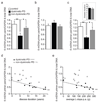Mitochondrial abnormalities in the putamen in Parkinson's disease dyskinesia
- PMID: 20740286
- PMCID: PMC2955799
- DOI: 10.1007/s00401-010-0740-8
Mitochondrial abnormalities in the putamen in Parkinson's disease dyskinesia
Abstract
Prolonged treatment of Parkinson's disease (PD) with levodopa leads to disabling side effects collectively referred to as 'dyskinesias'. We hypothesized that bioenergetic function in the putamen might play a crucial role in the development of dyskinesias. To test this hypothesis, we used post mortem samples of the human putamen and applied real time-PCR approaches and gene expression microarrays. We found that mitochondrial DNA (mtDNA) levels are decreased in patients who have developed dyskinesias, and mtDNA damage is concomitantly increased. These pathologies were not observed in PD subjects without signs of dyskinesias. The group of nuclear mRNA transcripts coding for the proteins of the mitochondrial electron transfer chain was decreased in patients with dyskinesias to a larger extent than in patients who had not developed dyskinesias. To examine whether dopamine fluctuations affect mtDNA levels in dopaminoceptive neurons, rat striatal neurons in culture were repeatedly exposed to levodopa, dopamine or their metabolites. MtDNA levels were reduced after treatment with dopamine, but not after treatment with dopamine metabolites. Levodopa led to an increase in mtDNA levels. We conclude that mitochondrial susceptibility in the putamen plays a role in the development of dyskinesias.
Figures





Similar articles
-
Resting-state connectivity predicts levodopa-induced dyskinesias in Parkinson's disease.Mov Disord. 2016 Apr;31(4):521-9. doi: 10.1002/mds.26540. Epub 2016 Mar 8. Mov Disord. 2016. PMID: 26954295 Free PMC article.
-
Levodopa-induced changes in synaptic dopamine levels increase with progression of Parkinson's disease: implications for dyskinesias.Brain. 2004 Dec;127(Pt 12):2747-54. doi: 10.1093/brain/awh290. Epub 2004 Aug 25. Brain. 2004. PMID: 15329355
-
Serotonergic markers in Parkinson's disease and levodopa-induced dyskinesias.Mov Disord. 2015 May;30(6):796-804. doi: 10.1002/mds.26144. Epub 2015 Feb 4. Mov Disord. 2015. PMID: 25649148
-
Molecular imaging of levodopa-induced dyskinesias.Cell Mol Life Sci. 2015 Jun;72(11):2107-17. doi: 10.1007/s00018-015-1854-x. Epub 2015 Feb 15. Cell Mol Life Sci. 2015. PMID: 25681866 Free PMC article. Review.
-
Pathophysiology of levodopa-induced dyskinesia: potential for new therapies.Nat Rev Neurosci. 2001 Aug;2(8):577-88. doi: 10.1038/35086062. Nat Rev Neurosci. 2001. PMID: 11484001 Review.
Cited by
-
Gene expression profiling in human neurodegenerative disease.Nat Rev Neurol. 2012 Sep;8(9):518-30. doi: 10.1038/nrneurol.2012.156. Epub 2012 Aug 14. Nat Rev Neurol. 2012. PMID: 22890216 Review.
-
Impact of L-DOPA treatment on regional cerebral blood flow and metabolism in the basal ganglia in a rat model of Parkinson's disease.Neuroimage. 2012 May 15;61(1):228-39. doi: 10.1016/j.neuroimage.2012.02.066. Epub 2012 Mar 3. Neuroimage. 2012. PMID: 22406356 Free PMC article.
-
Mitochondrial DNA depletion by ethidium bromide decreases neuronal mitochondrial creatine kinase: Implications for striatal energy metabolism.PLoS One. 2017 Dec 29;12(12):e0190456. doi: 10.1371/journal.pone.0190456. eCollection 2017. PLoS One. 2017. PMID: 29287112 Free PMC article.
-
Vascular endothelial growth factor is upregulated by L-dopa in the parkinsonian brain: implications for the development of dyskinesia.Brain. 2011 Aug;134(Pt 8):2339-57. doi: 10.1093/brain/awr165. Epub 2011 Jul 19. Brain. 2011. PMID: 21771855 Free PMC article.
-
Divergent Expression Patterns of Drp1 and HSD10 in the Nigro-Striatum of Two Mice Strains Based on their MPTP Susceptibility.Neurotox Res. 2019 Jul;36(1):27-38. doi: 10.1007/s12640-019-00036-8. Epub 2019 Apr 16. Neurotox Res. 2019. PMID: 30993548
References
-
- Ahlskog JE, Muenter MD. Frequency of levodopa-related dyskinesias and motor fluctuations as estimated from the cumulative literature. Mov Disord. 2001;16:448–458. - PubMed
-
- Bender A, Krishnan KJ, Morris CM, et al. High levels of mitochondrial DNA deletions in substantia nigra neurons in aging and Parkinson disease. Nat Genet. 2006;38:515–517. - PubMed
-
- Benjamini Y, Hochberg Y. Controlling the False Discovery Rate: A Practical and Powerful Approach to Multiple Testing. Journal of the Royal Statistical Society Series B (Methodological) 1995;57:289–300.
-
- Bernheimer H, Birkmayer W, Hornykiewicz O, Jellinger K, Seitelberger F. Brain dopamine and the syndromes of Parkinson and Huntington. Clinical, morphological and neurochemical correlations. J Neurol Sci. 1973;20:415–455. - PubMed
-
- Birkmayer W, Hornykiewicz O. Der Dioxyphenylalanin (=DOPA)-Effekt bei der Parkinson-Akinese. Wien Klin Wochenschr. 1961;73:787–788. - PubMed
Publication types
MeSH terms
Substances
Grants and funding
LinkOut - more resources
Full Text Sources
Medical

